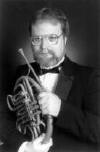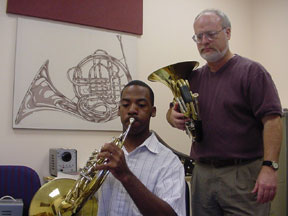|
Aural Imagery and Tone Development on the Horn by |
Perhaps the most important goal of any horn student should be the development and maintenance of a good, characteristic tone quality. Three primary factors are involved in the process of creating a sound; they are concept, breathing and active listening.
Where does the process of creating a sound actually begin? Is it the embouchure, the respiratory system or does sound begin at the mouthpiece? In reality, creation of the sound actually begins in the "mind's ear" with a mental concept of a sound to be produced.
Horn players are constantly advised to "hear the pitch before you play." Why not take it one step farther and challenge the horn player to "hear the sound (tone/tone color) before you play."
Aural imagery, mental concept and active imagination are indispensable when developing a great sound. The initial step in establishing aural imagery is to compile a list of simple descriptors of the components of a good sound. Here are some suggestions:
-
Size: There can be but one answer and that is large. Do not confuse this descriptor with loud. You will want the student to produce a "big" sound at any dynamic level.
-
Shape: Round is the most appropriate descriptor here. Can there really be any other shape to describe the ideal horn sound?
-
Temperature: The idea here is warm. One of the most appealing characteristics of a good horn tone is the inherent warmth in the tone.
-
Color: This descriptor is likely the most individual and personal of the components. Think of a color that relates to a warm, round sound. Choices may range from golden to purple. Try to avoid colors from extreme ends of the spectrum such as black or bright red!
-
Energy: The sound must be energetic and full of life. Choose adjectives like resonant or ringing for this component.
Once the student has chosen the descriptors
for the components of a great horn tone, challenge them to "hear"
such a sound in their mind. Students usually have a very active
imagination and it should prove easy to form this aural image
in the mind's ear.
Now that the aural image of a characteristic sound has been created, the student must breathe to create such a sound. Airflow is the life support system for tone production. Without sufficient airflow a strong sound cannot exist.
Simplicity is the key when relating breathing to tone production. Reduce the breathing process to the lowest common denominator; take large quantities of air into the body and return an energetic, constant airflow out of the body. Avoid excessive physical instructions when discussing respiration. These often lead to confusion and can result in restricting the breathing cycle rather than enhancing it. Strive to relate all instructions to sound. What better way is there to create a round sound than inhaling with a round vowel? Simply inhale with an "o" sound, then blow the "o" through the horn! Remembering the aural imagery of a large, round, warm, resonant sound, simply have the student "hear" that sound and breathe to create it. It is impossible to produce a large sound without inhaling a great quantity of air. Similarly, it is not possible to get a large, round sound without a fast, energetic air stream.
Maintaining a great sound depends on active listening. The student must be eternally vigilant to be aware that every note has the same quality and tone color no matter the range or dynamic. Encourage the student to produce note in the middle register with a large, round, warm, golden (insert your own choice) resonant sound. Once this is achieved, match other notes to this magic sound.
Producing a great, characteristic noble sound on the horn should not be a mysterious procedure. It is actually quite simple: conceive ("hear") the sound, then inhale and blow to create it!
| If you would like to be added to the TSMP Email Mailing List and receive periodic notifications of new articles and updates to this website, then please email TSMP.
The Texas School Music
Project is a source for ideas and information
concerning pedagogical
practices in the music classroom or rehearsal hall. The TSMP is a service provided to
all music specialists by the faculty
of
the Department of Music
at Stephen F. Austin State University. Copyright ? 2002, Department of Music at Stephen F. Austin State University |

